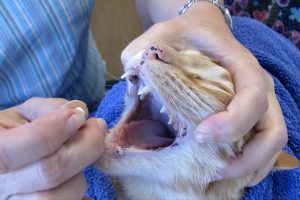
When it comes to having healthy, happy pets, there’s no substitute for proactive care. Photo: Paradise Pet Resorts (2017)
Owning a dog or cat can certainly be rewarding, but it also comes with a lot of responsibility. One of the biggest responsibilities is caring for your pet’s health, which includes both their physical and emotional well-being. To learn more about this, we’ve asked five Diamond Certified Expert Contributors to weigh in with tips for keeping your pet happy and healthy.
1. Physical health
Just like us, our pets require a regimen of regular exercise and proper nutrition to thrive. However, there are some finer points of pet health that are easy to overlook. Dr. Howard Schutzman of Antioch Veterinary Hospital points to dental hygiene as a prime example of this. “Periodontal diseases like gingivitis are commonly found in dogs and cats,” he says. “If left unchecked, these conditions can infect the deeper structures that support the teeth and even cause general health issues like kidney and organ damage. The best way to avoid these problems is to be proactive about your pet’s oral hygiene by brushing or wiping their teeth and gums daily.”
Since oral health problems have a tendency to escape notice, Dr. Schutzman offers a few signs to look for. “The most basic red flag is bad breath. While most people assume dogs’ breath is naturally bad, it’s actually a sign of bacteria developing inside the mouth. Other signs include swollen, red or bleeding gums; hesitancy or difficulty eating; and an uncharacteristic disinterest in playing with chew toys.”
Dr. Schutzman says another crucial aspect of pet health is regular visits to the veterinarian. “Ongoing veterinary exams are important because pets often don’t exhibit outward signs of illness or injury. Furthermore, even if your pet does exhibit symptoms, they may stem from something other than what you think. For example, if you have an old dog that’s having trouble climbing stairs, you might assume he has arthritis, but this actually could be a sign of heart disease. Taking your pet in for regular exams will enable your veterinarian to catch such issues early rather than in their advanced stages.”

When it comes to giving medication to a cat, knowing the right technique can make a big difference. Photo: Companion Animal Hospital (2017)
If your veterinarian detects an illness or other condition in your pet, he or she may prescribe a medication for you to administer at home. This can be a challenge with some pets, especially cats. Fortunately, as Dr. Donna Baird of Companion Animal Hospital explains, there’s a useful technique you can use for giving medication to a finicky feline. First, place your cat on a towel and wrap it in the folds until only its head is exposed (this will prevent its front paws from scratching you). Next, using one hand, tilt its head back and gently pull back on its upper lip with your thumb and forefingers, causing its mouth to open naturally. With your other hand, gently pull down its lower jaw to fully open its mouth. Pop in the pill (be sure it gets to the back of the tongue, near the throat) and close the cat’s mouth. Gently rub its throat and lightly blow air on its nose to encourage it to swallow.
To ensure your cat doesn’t spit out the pill, Dr. Baird recommends one final step: As you hold its head back, use an oral syringe to administer a small amount of water into its mouth. As before, close its mouth, rub its throat and blow on its nose.
2. Emotional health
Even if your pet is in great physical health, you also need to address their emotional health. As David Weiss of Four Paws Pet Ranch explains, this is particularly crucial for dogs due to their gregarious disposition. “Even though dogs have become a domesticated species over time, they’re still pack animals by nature, so it’s important for them to spend time among their own kind. One way to make sure this happens is to take yours to a local dog park. Dog parks are excellent resources, as they provide an ideal setting for both physical exercise and social interaction.”

In addition to nutrition and exercise, social interaction is a crucial aspect of canine wellness. Photo: Four Paws Pet Ranch (2017)
For dog owners whose pets are left home alone during the work week, Mike Campbell Paradise Pet Resorts suggests another option to ensure socialization: dog daycare at a local kennel. “Bringing your dog to daycare while you’re at work will give it a chance to play and interact with other dogs, which cultivates emotional wellness,” he says. “Plus, it provides a chance for them to get physical exercise, so it’s a win-win.”
Whether for daily daycare or boarding while you’re out of town, a local kennel can be a valuable resource. However, to ensure your pet is getting the best possible treatment, it’s important to be selective when choosing one. Susan O’Reilly of Dublin Creek Kennels, Inc. gives a few tips for finding a quality kennel. “First, ask around for recommendations. In addition to talking to friends, relatives and acquaintances, call the veterinary hospitals in your area. Veterinarians hear the good and bad about kennels from their clients, so they should be able to steer you in the right direction.”
Ms. O’Reilly says the next step is to personally visit the kennels you’re considering. “During your visit, be on the lookout for indicators of quality. Is the facility clean? Do the animals look happy? Do they all have beds? Assess the staff, too. Do the employees have a friendly demeanor? Are they knowledgeable? While you’re there, be sure to ask plenty of questions about the facility and its practices.”
